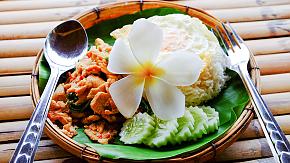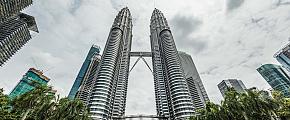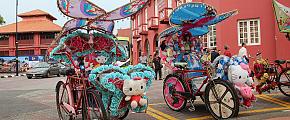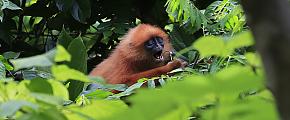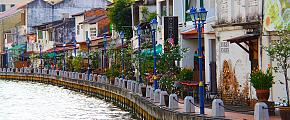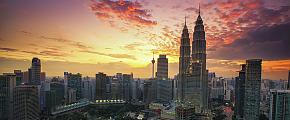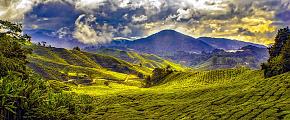Thaipusam Festival in Malaysia 2026
Thaipusam Festival is usually celebrated in January and February across Malaysia, Singapore, India, and other regions with Tamil living. Thousands of devotees dress in bright orange and yellow, chant, and walk to the temple to celebrate this Tamil Hindu festival. Sounds like a Thanksgiving or New Year's Event with huge parades? Far more than that!
Why Is Thaipusam Celebrated in Malaysia?
Hinduism makes up 6.1 percent of the Malaysian population, while Thaipusam is an important festival celebrated mostly by the Tamil Hindus. To them, it's time to ask Lord Murugan, son of Lord Shiva, for forgiveness, good health, and peace in the new year. The other version of the story goes that it's a festival to celebrate Lord Murugan's victory over evil.
During Thaipusam, devotees usually perform Kavadi Attam, a kind of ceremonial act, through dancing, offering food, and bodily self-mortification to commemorate Murugan, the god, offering spiritual liberation (mukti) and relief.
When Is Thaipusam Celebrated in Malaysia?
The name of the Thaipusam is the portmanteau of "Thai" and "Pusam". Thai is the name of a Tamil month. Pusam is the name of the star, which reaches its highest point during the festival. Based on that, it's not surprising that the exact date of the festival changes from year to year depending on the stars, usually it's in January and February. The date of the next Thaipusam festival is February 1, 2026.
Where Is Thaipusam Celebrated in Malaysia?
Thaipusam is a public holiday celebrated in several Malaysian states with parades in several major cities like Kuala Lumpur, Penang, Kedah(Sungai Petani), and Ipoh(Perak). In the capital, devotees will join a midnight chariot procession, chanting and inching their 15-kilometer way toward Batu Caves, and finally reach the temple in the cave through 272 steps. Hundreds of thousands of worshippers will join and escort a chariot bearing Murugan's statue with the sounds of drums and trumpets.
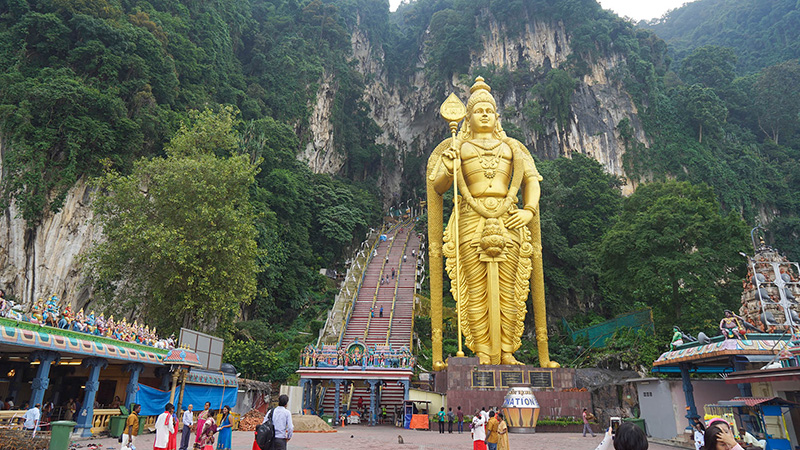 Batu Caves
Batu Caves
How Do Malaysians Celebrate Thaipusam?
Compared to other festivals, during the celebration activities, devotees would engage in various acts of devotion and control over their senses, which has a very strong visual impact, including piercing their skins, tongues, or cheeks.
Devotees Pierce Their Skin
Tamil Hindus believe that by "devoting part of the body", their sins will be cleansed, and their Hindu faith will be reaffirmed. Piercing the skin is one of these devotions; it symbolizes the burdens the devotees carry and is also a mark of their insistence, endurance, and willpower. The ritual itself is also a form of self-sacrifice to defeat the inner demons, banish anger, lust, and greed, and receive the blessing of Murugan. For instance, tongue and cheek piercing represents the sacrifice of speech and talking. Since Thaipusam is only one day each year, devotees begin to fast and cleanse for a certain period before the festival, the preparation can even last for up to 48 days.
Devotees Carry a Pot of Palkuddam (Milk)
It's believed colors yellow and orange are associated with Murugan. People will dress in these two colors, joining the procession. Some of them will carry a pot on their head, which contains milk, known as palkudam (pal kodum), an offering to the deity. At the end of the procession, people will pour milk over the statue of Lord Subramaniam, asking for the deity to grant their prayers. Others would also bring fruits as offerings or carry the kavadi (a decorated structure with several deities' images including Murugan) above the head.
Devotees Shave Their Heads on Thaipusam
You may also see many bald head devotees during Thaipusam because they (usually men) will shave their heads, a way to show respect to the god and past lives by cleansing the soul.
Devotees Enter a State of Trance
If you choose to visit Batu Caves during Thaipusam, you'll see many people in a trance or with mental spikes. Don't be surprised or shocked, the devotees are blessed by the god, and even the deity takes over their minds, which brings them great excitement and leads to dancing uncontrollably or waving their arms wildly. Through such spiritual experience, Arul Vaku, the devotees can experience the energies of the deity flowing through them.
Travel Tips for Attending Thaipusam in Malaysia
Taking Photos From the Vantage Point
Visiting Batu Caves' celebration is a special experience for tourists. It's estimated that over 10,000 tourists participate in the Thaipusam parades. The devotees will gather at the Sri Mahamariaman Temple along Jalan Tun HS Lee (Chinatown/Petaling Street area) in Kuala Lumpur. At night, the gatherings would depart at midnight, walking 15 km to Batu Cave, and arrive at the cave in the early morning on Thaipusam. As you can imagine, it will be extremely crowded. People push each other to move forward. There are two places to take photos of the crowd. One is walking towards the elevated highway to have a panoramic view of the procession.
The other is the "press platform" around Batu Caves. There's a photo point, a high "press platform" for news media and tourists, where they can wait to take photos of the devotees climbing the 272 steps. Also, there would be many booths and stalls selling snacks, drinks, and ritual goods with a tropical vibe. Tourists can also get good photos of them.
Getting to Batu Caves via Train
As thousands of people jostle each other on the street, rare tourists want to be pushed forward by the crowd or get stuck in the bus or taxi when the procession flows around, especially when the crowded air smells not too cool. It's better to take a shuttle train to avoid such a situation, to take the KTM Komuter from KL Sentral to Batu Caves station in 20 minutes. Besides, many extra special lines will run between KL Sentral and Batu Caves.
Being Well-Dressed in Countries with No Winter
As a tropical destination, temperatures in Malaysia fluctuate between 25 and 35 degrees Celsius during the year. Only two seasons exist in Malaysia, the dry and wet seasons. January is relatively dry. In January, the weather in Kuala Lumpur is mild with frequent rains, but different with the rain in the wet/rainy season. Still, it's the coolest month of the year. Tourists don't have to bring many heavy clothes, leave some space for umbrellas and sunglasses!
More Than Thaipusam? Have Fun in Cities Near Kuala Lumpur
As one of the best seasons of the year, in January, it's also recommended to visit Penang, Melaka, and Langkawi, to hike through the national parks, and enjoy the white beaches with sunshine.
From November to February, Penang gets cooler, has less rain, and is enjoyable to visit. You would love the feeling of walking in the areca catechu trees in Penang this season, and the authentic laksa would impress you with a blended flavor of spicy, savory, umami, and sweet.
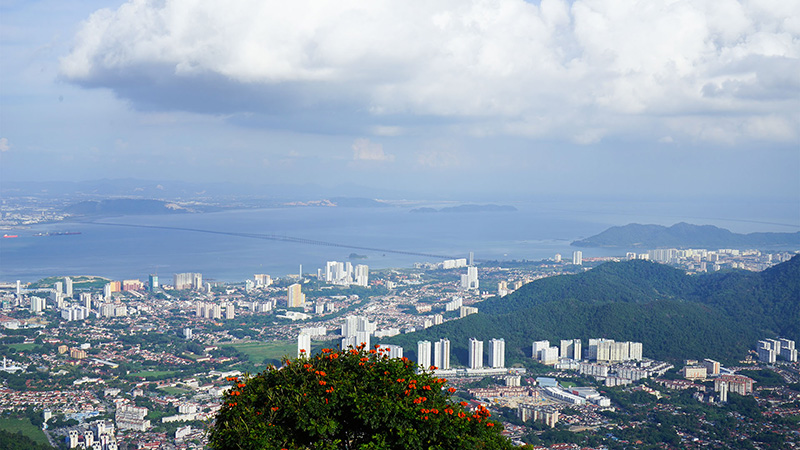 Penang
Penang
Since you already plan to set a footprint in Malaysia, there's no reason not to visit Melaka, where the Eastern and Western cultures collide and mix. You can find the hallmark of Dutch people in Stadthuys and Dutch Square, the oldest church in Southeast Asia, built by the Portuguese, and howthe Chinese architectural style was localized in Melaka and dates back to the Ming Dynasty (14~17th Century).
 Malacca
Malacca
Known as the Jewel of Kedah, the entire island of Langkawi is a national park, with even more extensive mangrove landscapes. On the horizon, take a boat and explore the mangrove during the months when the waves become smooth. Up to the sky, less rain means you're more likely to take clear pictures of the Skybridge and amaze your Facebook and Instagram friends.
Quick Question
What Our Clients Say
Explore the latest verified reviews of Odynovo's travel services on Tripadvisor, Google, Trustpilot, Product Review and more trusted platforms.

